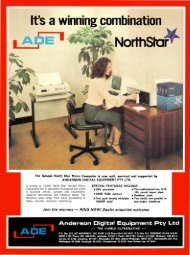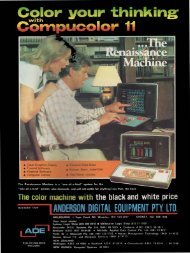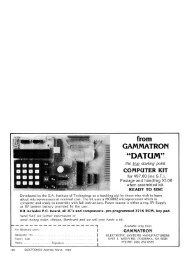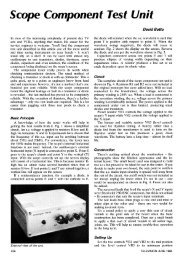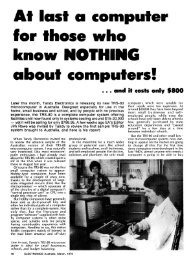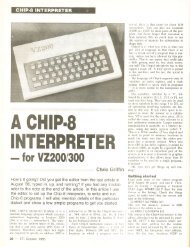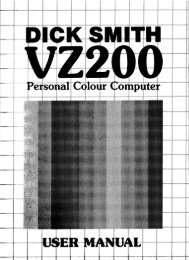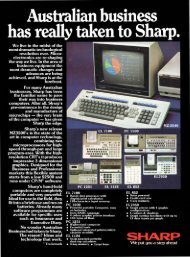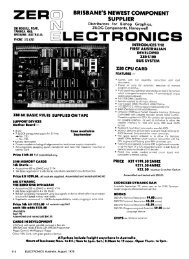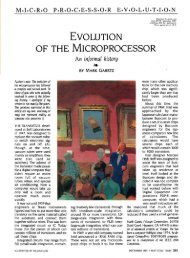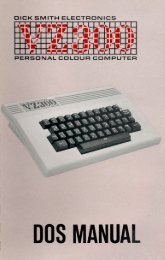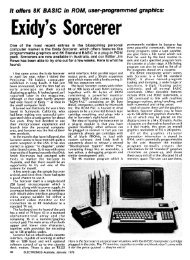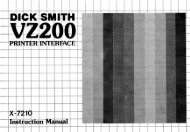Applied Technology and Microbee adverts. - The MESSUI Place
Applied Technology and Microbee adverts. - The MESSUI Place
Applied Technology and Microbee adverts. - The MESSUI Place
Create successful ePaper yourself
Turn your PDF publications into a flip-book with our unique Google optimized e-Paper software.
MicroBee IC computer<br />
ing us back into Basic. It was no surprise,<br />
but extremely frustrating, to return to<br />
the word processing program <strong>and</strong> find<br />
that all the text in memory had been<br />
erased.<br />
Network communications<br />
An outst<strong>and</strong>ing feature of the<br />
MicroBee IC is the provision of network<br />
communications software in Read Only<br />
Memory. <strong>The</strong> Network ROM is activated<br />
with the comm<strong>and</strong> NET from Basic or by<br />
selecting the "N" option of the WordBee<br />
interface menu <strong>and</strong> allows word processor<br />
files <strong>and</strong> Basic or machine code<br />
programs to be transferred into <strong>and</strong> out<br />
of the computer, either via a modem or<br />
a direct RS232C link to another system.<br />
Once activated the network ROM<br />
displays a menu of comm<strong>and</strong>s <strong>and</strong> options<br />
to be used for setting communication<br />
parameters. St<strong>and</strong>ard transmission<br />
rates from 110 to 4800 baud can be<br />
selected, data format established <strong>and</strong><br />
either full or half duplex communication<br />
initiated from this menu.<br />
For modem communications the<br />
default transmission speed is 300 baud,<br />
but a terminal emulation mode can also<br />
be selected at speeds of up to 1200 baud<br />
to allow the MicroBee to be connected<br />
directly to a host computer. If two<br />
MicroBees were connected via an<br />
RS232C link data can be transferred at up<br />
to 4800 baud, while intermediate baud<br />
rates are provided to allow the use of a<br />
wider range of serial printers.<br />
Other facilities are also provided by the<br />
network ROM in conjunction with Basic.<br />
<strong>The</strong> Basic comm<strong>and</strong> OUT#6 now sets<br />
the screen to an 80 x 24 lines format, as<br />
used by the terminal emulation routines<br />
of the NET program. Under Basic this<br />
facility is of limited use, as graphics,<br />
screen positioning comm<strong>and</strong>s <strong>and</strong> the<br />
CLS statement are not supported in this<br />
mode. A second comm<strong>and</strong>, IN#7,<br />
selects input from the buffere,1 RS232C<br />
port, while 11 selects input from the<br />
parallel port. <strong>The</strong> manual for the IC suggests<br />
that some users may like to add an<br />
encoded external keyboard (either<br />
parallel or serial) to suit their own requirements,<br />
<strong>and</strong> these two comm<strong>and</strong>s<br />
make the addition easy.<br />
<strong>The</strong> communications protocol used by<br />
the network ROM is one which has been<br />
publicised as the "Ward Christensen" format,<br />
widely used by hobbyist <strong>and</strong> commercial<br />
networks in the United States<br />
<strong>and</strong> gaining increasing popularity in<br />
Australia. One factor in this wide support<br />
is that various programs are available to<br />
implement the protocol under CP/M,<br />
allowing communication between the<br />
MicroBee <strong>and</strong> CP/M systems. A number<br />
of computer clubs have also announced<br />
126 ELECTRONICS Australia, November, 1983<br />
plans for computer bulletin boards based<br />
on the MicroBee <strong>and</strong> this communications<br />
protocol.<br />
Machine language monitor<br />
An extensive monitor program is also<br />
provided by the MicroBee IC. Accessible<br />
from Basic, NET or WordBee, this<br />
monitor includes comm<strong>and</strong>s for examining<br />
<strong>and</strong> modifying the contents of<br />
memory, running machine language programs,<br />
moving blocks of memory <strong>and</strong><br />
searching memory for a particular pattern<br />
of characters. Other routines provide<br />
direct access to the NET comm<strong>and</strong>s<br />
for sending <strong>and</strong> receiving data files <strong>and</strong><br />
saving <strong>and</strong> loading files from tape at<br />
1200 baud. <strong>The</strong> MicroBee IC manual also<br />
provides the details required to allow a<br />
user program to make full use of the<br />
communications routines contained in<br />
the network ROM.<br />
Both the monitor <strong>and</strong> the networking<br />
ROM allow the user to activate the<br />
MicroBee's self-test routine which provides<br />
a screen display <strong>and</strong> automatic<br />
check of the functioning of the<br />
keyboard, ROM <strong>and</strong> RAM <strong>and</strong> the<br />
character generators of the system. Just<br />
what you do when a fault is reported is<br />
not mentioned however. A troubleshooting<br />
guide, internal details <strong>and</strong><br />
circuit diagrams are not included in the<br />
MicroBee manual.<br />
<strong>The</strong> Hardware<br />
Internally the MicroBee consists of two<br />
circuit boards, one containing a mixture<br />
of RAM <strong>and</strong> ROM <strong>and</strong> the other carrying<br />
the Z80 microprocessor, support chips,<br />
video display circuitry <strong>and</strong> keyboard. A<br />
programmable tone generator <strong>and</strong><br />
cassette interface are also provided.<br />
MicroBee IC Specifications<br />
Processor<br />
RAM<br />
ROM<br />
Interfaces<br />
Keyboard<br />
Display<br />
<strong>The</strong> MicroBee 32, as the name implies,<br />
provides 32K bytes of programmable<br />
memory while the other half of the<br />
memory board has provision for up to<br />
28K of Read Only Memory. MicroWorld<br />
Basic occupies 16K, with the remaining<br />
space available for the WordBee, NET<br />
<strong>and</strong> monitor ROMs. A feature of the<br />
MicroBee is its use of CMOS memory<br />
which draws very little current. A 4.5V<br />
battery• provides sufficient power to<br />
allow the memory to be maintained on<br />
st<strong>and</strong>by when the main supply is switched<br />
off. Programs <strong>and</strong> text in memory are<br />
retained between uses unless explicitly<br />
erased.<br />
At the rear of the machine is a 25-pin<br />
D-type connector for the RS232C serial<br />
interface <strong>and</strong> a 15-pin connector which<br />
gives access to the pins of a Zilog PIO<br />
(Parallel Input/Output) chip. As it st<strong>and</strong>s<br />
this ,port is unsuitable for driving a<br />
parallel printer <strong>and</strong> requires an additional<br />
IC <strong>and</strong> a few minor components.<br />
This circuit was incorporated in the<br />
printer cable of the review machine.<br />
Two other openings at the rear of the<br />
case are provided for later expansion of<br />
the system <strong>and</strong> the circuit board is<br />
designed to allow for the addition of an<br />
expansion interface connector. <strong>The</strong>re is<br />
not enough information available to<br />
make this practicable for the average<br />
hobbyist, however.<br />
In conclusion<br />
With an array of built-in software;<br />
powerful Basic interpreter, word processor<br />
<strong>and</strong> communications programs,<br />
the MicroBee IC seems ideally suited for<br />
the hobbyist. Deservedly the machine is<br />
also attracting a lot of attention in the<br />
educational field because of its potential<br />
as a teaching system, <strong>and</strong> software for a<br />
wide variety of applications is becoming<br />
available.<br />
<strong>The</strong>re may be problems with business<br />
Z80 at 3.375MHz clock rate<br />
32K plus 4K for video<br />
28K<br />
RS232C <strong>and</strong> parallel ports<br />
60 keys, typewriter style<br />
64 x 16 lines upper <strong>and</strong> lower case,<br />
underline <strong>and</strong> inverse graphics modes<br />
80 x 24 terminal emulation mode<br />
Graphics Low resolution 128 x 48<br />
High resolution 512 x 256 using programmable<br />
characters. A colour option is<br />
available<br />
Sound<br />
25 tones with duration in increments of<br />
Y. second<br />
Software in ROM<br />
MicroWorld Basic<br />
WordBee 1.2<br />
Network communications<br />
M/L monitor<br />
Documentation Reviewed EA, July 1983, page 118



